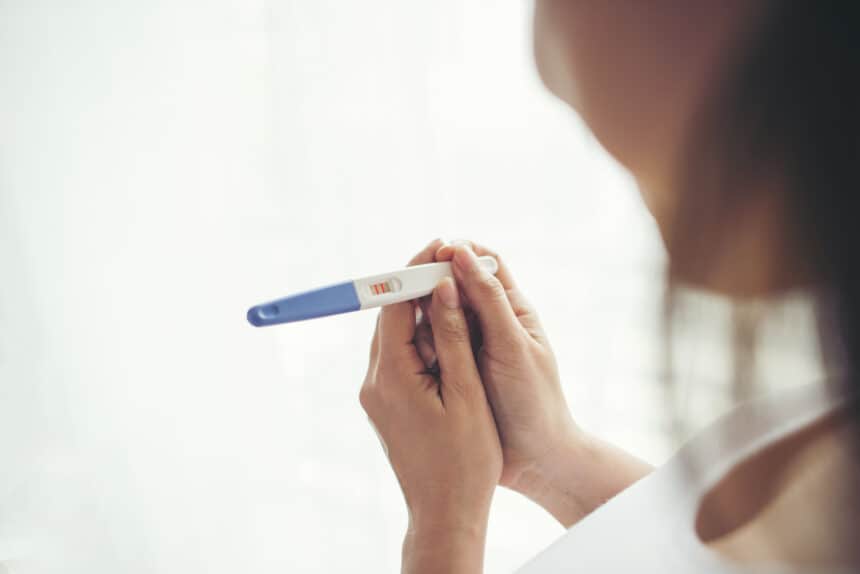No matter what you hope for, taking a home pregnancy test can be quite a stressful experience. Especially when you aren’t even sure that you will get the correct result. Although quite advanced by now in detecting pregnancies, tests are still possible to show a false-positive or a false-negative result.
But how do you know if you’re in that situation at the moment? To get all the answers and truly understand when tests give false results, we will review better what tests are, how they work, and what causes them to be incorrect.
What Is a Pregnancy Test, and How Does It Work?
Home pregnancy tests check your urine or blood for a pregnancy hormone called human chorionic gonadotropin (hCG). This hormone is present in the blood if and when a fertilized egg attaches to the uterus wall.
Although this hormone appears since day 1 of your missed period, it peaks 5 to 7 days after the fertilization. Pregnancy tests around this time prove most accurate, even though many good ones claim to be precise since day one of your missed period.
Later on in the pregnancy, the hCG hormone levels rise quickly, doubling every 2 to 3 days.
What Types of Pregnancy Tests Are Available?
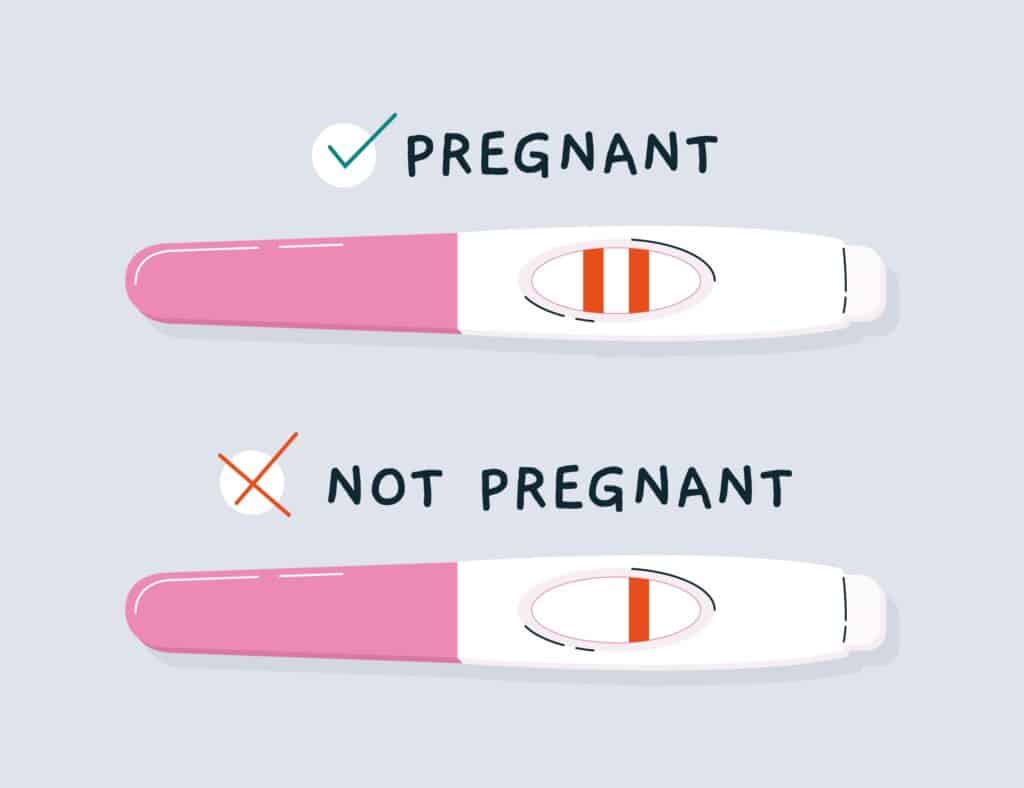
Two main types of pregnancy tests detect the content of the human chorionic gonadotropin hormone. Blood and urine tests. First, we will talk about the blood test.
Blood Tests
You can do testing for pregnancy through the blood at your doctor’s office only. These tests aren’t used as often as urine tests, but they are considered more accurate and can detect pregnancy earlier than a home pregnancy test.
If you are eager to know whether you are pregnant or not, taking a blood test as early as 6 to 8 days after ovulation can give you results.
The blood tests are further divided into qualitative and quantitative hCG tests.
The qualitative pregnancy test checks for the hCG hormone content and can only tell you whether you are pregnant or not. You can do this pregnancy test as early as 10 days after conception. Some can detect hCG much earlier and give you peace of mind.
On the other hand, a quantitative pregnancy test is used to measure the exact amount of hCG (beta hCG content) in your blood. These tests aren’t used very often to determine pregnancy at its initial stages but instead track problems during the nine months.
Such a pregnancy test can be done to detect ectopic pregnancy, when the fertilized egg implants outside your uterus, or a miscarriage when hCG levels fall quickly.
Urine Test
Urine pregnancy tests are the most commonly used tests to detect pregnancy. You can take these at home or even at your doctor’s office.
Urine tests are pretty accurate if you follow the directions, but some may give incorrect results in certain instances. When used at home, the process is similar for all:
- You hold the stick under your urine stream or,
- Collect your morning urine in a cup and dip the test stick into it
Then you wait anywhere from 3 to 7 minutes as per the directions from your test. You can always confirm this result with your doctor to give you more sensitive pregnancy tests or run additional blood tests.
How Accurate Are Pregnancy Tests?
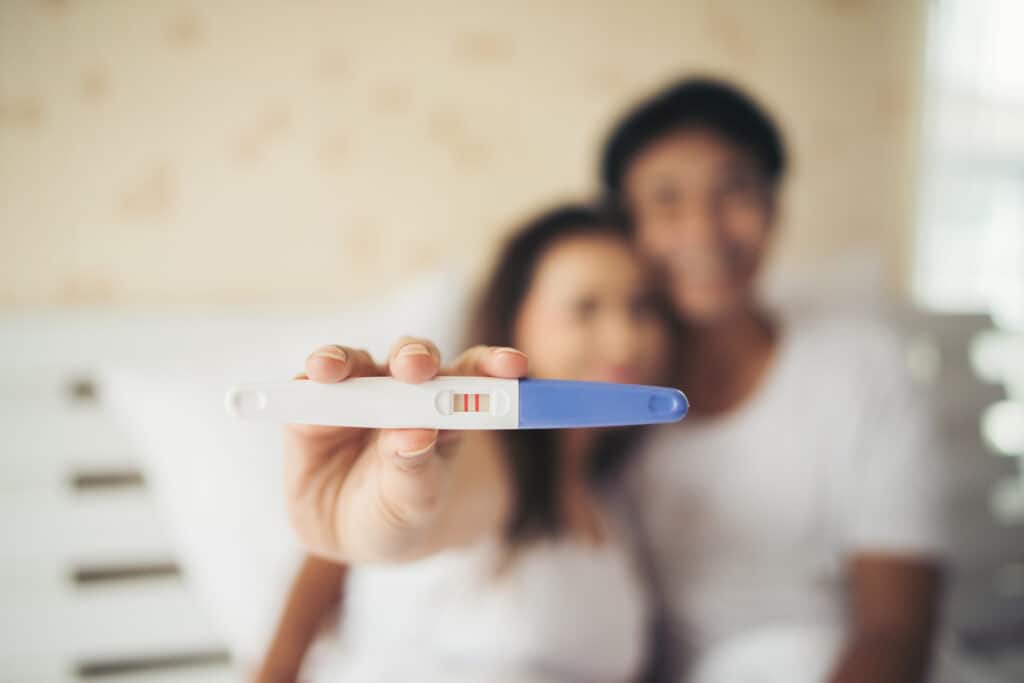
Although blood tests are more accurate, you can also rely on home pregnancy test results with an accuracy of over 96%. However, certain things affect a home test’s data.
- How closely you followed the instructions
- Your ovulation process and how soon the egg implants
- When you tested after fertilization
- The sensitivity of the pregnancy test itself
When to Take a Urine Test?
You may notice in your pharmacy that home pregnancy tests claim to give accurate data even after day 1 of your missed period. Although this is the case for some, we recommend waiting at least 5 to 7 days. Also, test first thing in the morning when your urine is the most concentrated with the hCG hormones.
Understanding the Result
Depending on the type of home pregnancy test you are taking, the results will show up as a “+” for pregnant or “-” sign for not pregnant.
Depending on the type of test, this information may be differently presented. Some tests will show one line for a negative test and two parallel lines for a positive result.
If you are using a digital device, you will see “pregnant” or “not pregnant” written on the display of the test.
If the pregnancy test is positive, it means you have high hCG levels in your urine. However, you may get a false-positive pregnancy test if:
- You have blood in your urine
- If you have protein in your urine
- You have recently taken tranquilizers, anticonvulsants, hypnotics, or fertility treatments.
If you get a negative pregnancy test, you’re probably not pregnant and don’t have any hCG in your body. However, just like the false-positive test, there are causes for a false negative pregnancy test result, such as:
- The test is past its expiration date.
- You didn’t follow the instructions of the test well
- You tested too soon
- You didn’t use it first thing in the morning, and your urine is diluted from drinking a lot of liquids throughout the day.
- Drugs like diuretics or antihistamines can also produce a false negative (below, we talk more about the certain medicines that can produce a false-positive below).
Regardless of the result, if you want to be sure, wait for a week to retake the test.
If a few tests tell you differently, it is best to run a blood test to find out if you are pregnant or not.
Home Pregnancy Tests: Can You Trust the Results?
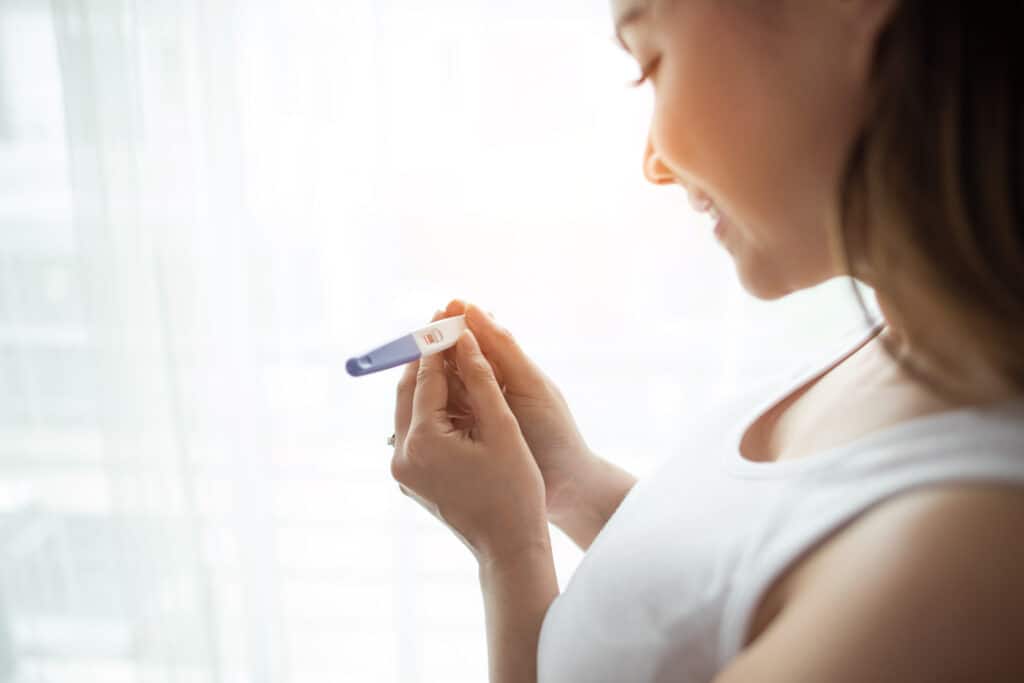
Can you trust the information you get on your test device? In this part, we will review in-depth the reason why your pregnancy test showed a false positive. If you find yourself in any of these situations, it is best to opt for a quantitative or qualitative blood test to detect the earliest stages of pregnancy through hCG.
Chemical hCG Pregnancy
A chemical pregnancy isn’t an actual positive pregnancy. Still, it only happens due to the natural fertilization processes in your body, namely, if the egg or embryo cannot implant or grow because of previous fibroids, scar tissue, a congenital uterine anomaly, or even very low amounts of progesterone in the body.
This tissue still produces hCG and leads to a false-positive pregnancy test.
Ectopic Pregnancy
Ectopic pregnancy is when the fertilized egg is implanted outside of the main cavity of the uterus. The egg is stuck in the fallopian tube during its journey, so ectopic pregnancy is also known as a tubal pregnancy. Ectopic pregnancy often occurs in the cervix, ovary, or abdominal cavity.
There are some reasons why such a pregnancy might occur:
- Scared tissue or inflammation in the fallopian tube
- The irregular shape of the fallopian tube
This tissue produces the hCG hormone into the bloodstream until it is removed, resulting in the false-positive pregnancy test.
Uterine Infections
An ectopic pregnancy isn’t a viable one as the embryo isn’t located in the uterus. Because of this, there is no place for it to grow or thrive, and it has to be aborted. The embryo produces hCG, even though it is implanted wrongly. This causes a false-positive pregnancy test, and in this case, you need to see your doctor immediately.
Such pregnancies are medical emergencies because those are damaging to the woman if left untreated. Extreme blood loss or loss of the reproductive organs can occur.
With that said, here are some of the symptoms you may be experiencing with ectopic pregnancy:
- Nausea and sore breasts (just like with a normal pregnancy)
- Sharp pain in the abdomen, pelvis, shoulder, or neck
- Continual pains on one side of the abdomen
- Light or even heavy vaginal spotting or bleeding
- Feeling dizzy or fainting
- Feeling an unusual pressure on the rectum
If you feel any of these symptoms and get a positive test, you should immediately seek medical help.
Pregnancy Loss
If you have recently had an abortion or a miscarriage, the test may still be positive because of the leftover hCG levels in the blood.
Sometimes it can take even up to six weeks after a pregnancy loss for the hormone to completely disappear from your bloodstream, so if you get a positive test during this period, it may be a false positive.
Evaporation Lines
Home pregnancy tests usually have two lines for pregnant and one for not pregnant. However, even though their color is bright pink, red, or blue, there still can be an evaporation line near the main one that you may misinterpret as a positive result.
To avoid a false-positive by evaporation lines, you need to follow the instructions well and wait for exactly the time stated on the test. Usually, the evaporation line disappears after the 5 or 7-minute mark, leaving the one line clear.
Taking Certain Medications
If you are using fertility medications to aid fertilization, as proposed by your ob-gyn, you may get a false positive on your home pregnancy test. This is because you are taking the synthetic hCG trigger shot such as:
- Novarel
- Pregnyl
- Ovidrel
- Profasi
This shot helps your follicles release mature eggs. If you take a home pregnancy test too early in the month, you may get a false-positive pregnancy test.
Additionally, there are several other types of medications that can also cause a false-positive pregnancy test:
- Anti-anxiety medications
- Antipsychotics
- Anticonvulsants
- Parkinson’s disease medications
- Diuretics
- Methadone (Dolophine)
- Specific Medical Conditions
Certain medical conditions can contribute to a false-positive home pregnancy test. These include:
- UTIs
- Kidney disease leads to you having proteins or blood cells in the urine
- Ovarian cysts
- Ovarian cancer
- Pituitary problems
Personal Error
Although directions are pretty simple, it is still possible for people to misinterpret or not follow them. This will be the reason to get a positive test result even if a woman isn’t pregnant or a negative when she is. Firstly, you should check the expiration date.
Then, you should ensure that you aren’t taking the test too early during your ovulation. This will result in the hCG levels not being high enough and produce a negative result.
Lastly, you should be mindful of the time you need to keep the test dipped in urine and the waiting period. If you have kept it for too long, you will dilute it excessively and show a negative even when the result is positive.
What Happens Next?
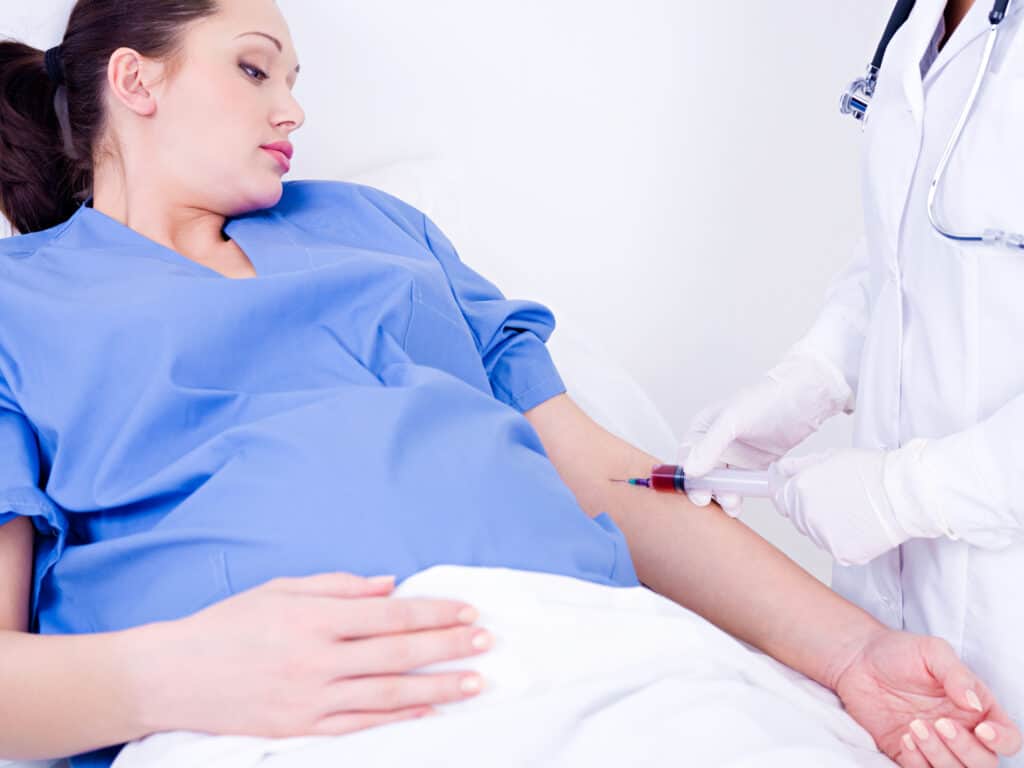
When you have taken a few different home pregnancy tests, and all came with different results, it is best to see your doctor and run a blood test or even an ultrasound, depending on how far pregnant you are. This health information can save your and your baby’s life.
Whatever the outcome may be, the bottom line is, the sooner you confirm these results, the better it is because you will be able to take prenatal care and decide what to do next.
As for the negative test results when you are missing your period, it doesn’t necessarily mean that you are pregnant and that the result is incorrect. Missing your period can occur due to many reasons like thyroid disorders, low body weight, problems with your ovaries, or excessive stress and exercise.
Regardless of the result you are hoping for, if you miss your period but not pregnant, you need to run some blood tests and get your doctor to help you gain your menstrual cycle back on track.

